The practice of stone inscriptions by the Pallavas and Cholas at Uttiramerur is one of the great legacies of that era.
Uttiramerur – Democratic tenets inscribed on stone
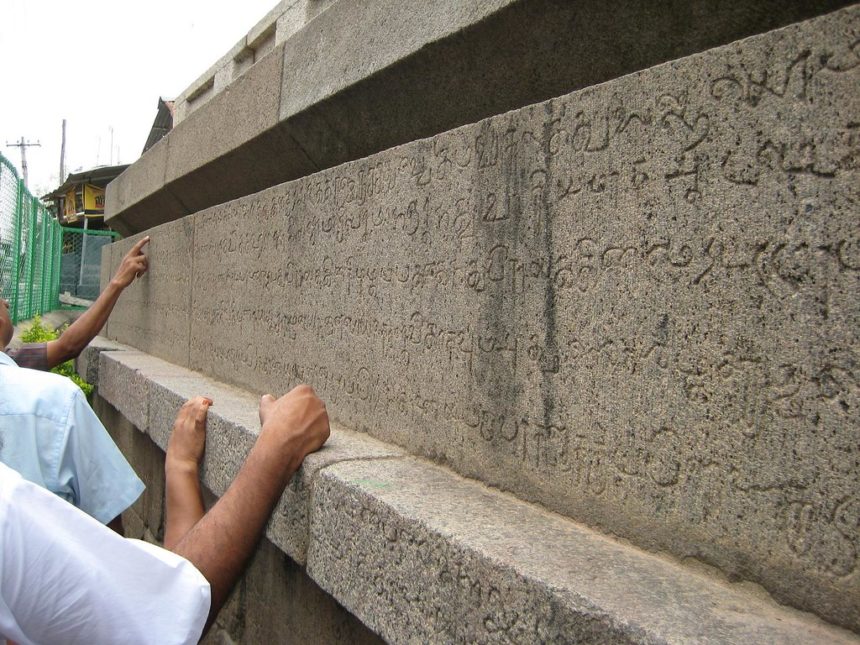
In the bustling small town called Uttiramerur in the historic district of Kanchipuram, about 90 km from Chennai (30 kilometres south of Kanchipuram town) stands an eleven hundred-year-old non-descript temple known as the Uttiramerur Vaikunta Perumal Temple. This temple is unique as the walls of its high granite base are inscribed with the democratic procedures meant for electing the representatives for local self-governance at the village level.
The History of Democratic Principles in India dates back to the early historical era. The concept of implementation of Law based on the decisions of an assembly of citizens is as old as the historical records in India.
Some Mahajanapadas of the 7th Century BCE were democratic Republics, the most prominent being the Lichhavis of Vaishali (in present-day Bihar). Buddhist and Jain texts of the 6th – 5th centuries BCE give a clear understanding of the republics with the participation of an assembly of citizens in administration, legislation and judiciary. Officeholders were elected to preside over the Assembly and State. Sometimes they were given the title of Raja. The concept of the monarchy at the top and some form of democracy at the local level co-existed during this era. Greeks have also recorded their interaction with such Republics on the northwest border of the Indian subcontinent during their interaction with India in the 4th century BCE.
South India has a history of illustrious rulers going back to the early centuries of the Common Era. The Cholas, Pallavas, Pandyas, Cheras are some of the well-known dynasties that brought socio-economic, cultural and religious growth and stability in the southern peninsular.
The Pallavas ruled the area of Kanchipuram till the 9th century CE, after which the Cholas took control of the area. The village of Uttiramerur in Kanchipuram was an important socio-cultural place. It is said that Nandivarman II had donated the village to Brahmins of the Vaishnava sect around 750 CE and it was originally known as ‘Uttiramerur Chaturvedi Mangalam’. The Cholas came into power in this region towards the end of the 9th Century CE. Parantaka Chola ruled from 907-950 CE and his empire included Kanchipuram, Tanjavur and Trichy that was earlier under the Pallavas and Pandyas.

I had heard about this temple and was excited to visit it. The journey was through densely populated settlements in Uttiramerur town. In the heart of the settlements stand this monument of pride and devotion. From afar it looks desolate, but this temple is of much importance to the locals as it traces the rich history of the area.
The Temple is east facing and is built of granite slabs. It is a simple construct compared to the elaborate and intricate temple structures of those times such as the Kailasanathar and Vaikunth Perumal Temple at the heart of Kanchipuram town. In fact, the other temples of this town are much more elaborate. But the presence of the village assembly hall makes this small structure the focal point around which all other temples are oriented. The presiding deity is Lord Vishnu along with his consorts, Bhudevi and Sridevi. There is a balipeetham and dhvajastambh in front of the temple steps. There is a lone sculpture of the iconic Pallava lion to the left of the said stairs.
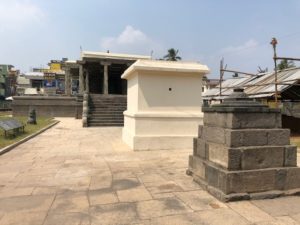
(Balipeetham and dhwajstambh stand in front of the main temple)
The Vaikunta Perumal Temple was not only a place for worshipping Vishnu but was also a place for village assemblies from the times of Pallava rule, especially under Nandivarman II, during the mid-8th century CE. There are multiple inscriptions all around the massive base wall of this temple. The Pallava king Dantivarman (795-846 CE) has the earliest inscription where he mentioned the ‘Sabha’ and the ‘Ur’ as the two assemblies of villagers tasked with duties to manage public affairs. Some inscriptions relating to temple administration belong to the Pallava King Nandivarman III (CE 846-869). During this period the executives working under the Sabha were known as Variyars, These individuals were tasked with administration responsibilities on behalf of the assembly.

(The different levels of the high base wall with inscriptions all around)
The mandapam of stone pillars that exist today was built by the Chola kings, particularly, Kolutunga Chola, who repaired the roof. The pillars that hold this mandapam are typical Chola constructs with a ‘T’ shaped structure on the top. The pillars are plain and bereft of any ornamentation as if signifying the solemnity of the meeting place where all the decisions were taken regarding the village administration.
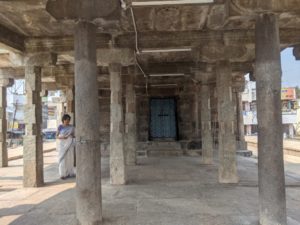
(The pillared mandapam. Typical Chola pillars that hold the roof of the mandapam)
The famed Inscriptions giving extraordinary details about the election process inscribed by Parantaka Chola I (907-950 CE). The inscriptions laying out the detailed rules concerning the Panchayat election principles have been inscribed on the western side of the base of this temple. The language is old Tamil and so is the script.
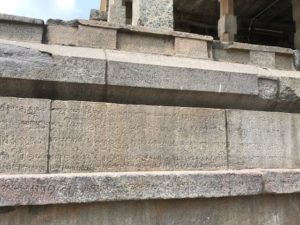
(Inscriptions on the front face)
These inscriptions are dated to around 920 CE. The village assembly met and adopted the rules. These are very detailed and meticulous, justly recognised as an unparalleled achievement in the annals of local self-governance. The administration was done by committees called Variyams who were selected by the assembly. This progression from an individual executive (Variyar) to the committee(Variyam) shows the progression towards more democracy.
The village area was divided into thirty wards and candidates were to be chosen from every ward. The mandatory qualifications to contest as a ward member have been clearly specified and in many ways. These over millennium-year-old rules can show a better path to democracies today.
The age limit was fixed between 35 and 70. The upper limit was such an important step to prevent a gerontocracy and safety valve against the continued dominance by entrenched interests. Basic qualification included property ownership, ownership through legal means and administrative ability.
There is a long list of disqualifiers such as being a cheat, guilty of incest, committed a sin etc. Every possible detail of mishandling public affairs is listed as a disqualification like, not submitting a proper account of the committee, misappropriation of property, acting against the interest of the society, being a danger to peaceful life etc. This disbarment is applicable to all his family and extended family members including his wife’s family. Imagine a society where it is essential for every member of the family and extended family to be free of blemish to be permitted to contest ward elections. It is unthinkable in today’s world.

(The inscriptions on the west face of the parapet that lays down the rules for local self-governance)
The mode of election is meticulously set out in these inscriptions. Names were to be placed in a pot and tickets of each ward were to be handled separately. The pot tickets were drawn in the presence of the Great Assembly including the young and the old members. Attendance to the assembly was compulsory for every member barring the physically infirm. The pot tickets for one ward was taken out and kept in another pot and shaken well. A young boy would then draw out a ticket and place it on the open palm of an arbitrator or Madhyastha. The ticket name would then be read out by him for all to hear. The name would be put down by the scribe present there. Similarly, one man would be chosen for each of the thirty wards. What is to be noted is that all plausible chances of any kind of cheating while selecting the candidate from the pot of tickets is overruled. A young child takes out a ticket and places it on the open palm of the receiver to ensure that there was nothing else in his hand that could raise any untoward doubt towards foul play. Given the present mismanagement in the process of conducting elections in even the so-called advanced democracies in the western world, one can only marvel at the foresight of our ancestors who created guidelines with such exactitude to avoid any wrongdoing or even suspicion of wrongdoing.
It is no wonder that India has the biggest written constitution and the election processes here are the most detailed, covering all processes, however small and insignificant they may seem. This detailing is one of the core reasons why elections are always successful in a chaotic democracy such as ours. The stone walls of Uttitamerur are a silent witness to the fact that India had a similarly robust system more than a thousand years ago.
In a similar way, committees for Garden, Tank, ‘Pancavara’ and Gold were constituted from among the eligible members. The duration of the appointees was for one year and a member was barred from contesting again for three years. These committees were meant to oversee the social and economic affairs of the relevant sectors.
Any person found guilty of any wrongdoing was immediately removed.
It was the King’s order that as long as the moon and the sun existed, the committees will be appointed by pot-tickets alone. The Royal decree was given by the glorious Parakesarivarman, who was none other than Parantaka Chola.
Apart from the core election-related inscriptions, there are many more inscriptions by various Chola rulers like Rajendra Chola, Rajaraja Chola I and Kulotunga Chola. These inscriptions give us a window into understanding how the affairs of the village were conducted based on well-codified principles. The village assembly was empowered to deal with administrative, judicial, commercial, agricultural, irrigation and transportation-related issues. It is clear that even in the era of a strong monarchy, the day to day affairs in almost all matters was left for the assembly to administer. As one walks across the beautifully written texts going on and on, across all layers of stone, the sense of awe never diminishes at this grand display of this great administrative system.
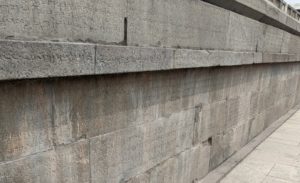
(Beautifully carved testament for the ages)
These rules seem to have been applicable to the community comprising mainly of Brahmins in the village of Uttiramerur. What is to be remembered is that this democratic administration at the village level existed even though there was a mighty king who ruled a vast expanse of peninsular India. Even in the regime of one of the mightiest dynasties of the monarchy, the village level self-governance was doing well with the royal patronage. From the standpoint of the current democratic norms, this system may not qualify on the touchstone of universal access, but it has to be noted that it has taken a lot of time for the modern world to reach the current understanding of democracy based on universal suffrage. Given the realities of the governing systems of that era, it was indeed a great marvel.
Some examples of the timelines associated with modern democracies are worth examining in this context. The American declaration of independence was signed in 1776 with the involvement of great visionaries and thinkers like Thomas Jefferson and Benjamin Franklin. But it still treated slaves as part-human till the 1860s and only after the civil war was it recognised (constitutional amendment in 1868) that African Americans could also be treated as citizens. Even this grudgingly given right remained on paper in large parts of the country and it took them almost 100 years to clearly legislate that African Americans cannot be discriminated against. The reality of not allowing this particular group to easily register and vote is still going on and the USA States are passing laws in 2021 outlawing giving water to people in voting queues and stopping voting on Sundays. To this great egalitarian society, it took a long fight by a lot of women to put across to the decision-makers that women are also human and citizens. It is incredible that women were allowed to vote in the USA only in 1920, a long 144 years after the Declaration of Independence.
The French revolution of 1789 was based on the noble declaration of Liberty Equality and Fraternity, but it did not allow women to vote till the Second World War ended in 1945.
Conclusion
The practice of stone inscriptions by the Pallavas and Cholas has left us many important historical details and Uttiramerur inscriptions are one of the great legacies of that era. The insistence on probity in public life was the unique feature of the local self-governance. The detailing available regarding the various definitions and the process of the election shows the maturity of the society. Even within Tamilnadu there are other sources giving details of similar practises in other areas, but no other source even comes close to such detailing. Our current constitution was drafted after consulting all the great constitutions of the modern world, but its opening sentence eerily matches the 1100-year-old declaration in Uttiramerur which proclaims proudly:
“We, the members of the assembly of Uttiramerur Chaturvedi Mangalam, made this settlement for the prosperity of our village in order that wicked men may perish and the rest may prosper”(according to one version of villagers declaration).

Leave a Reply